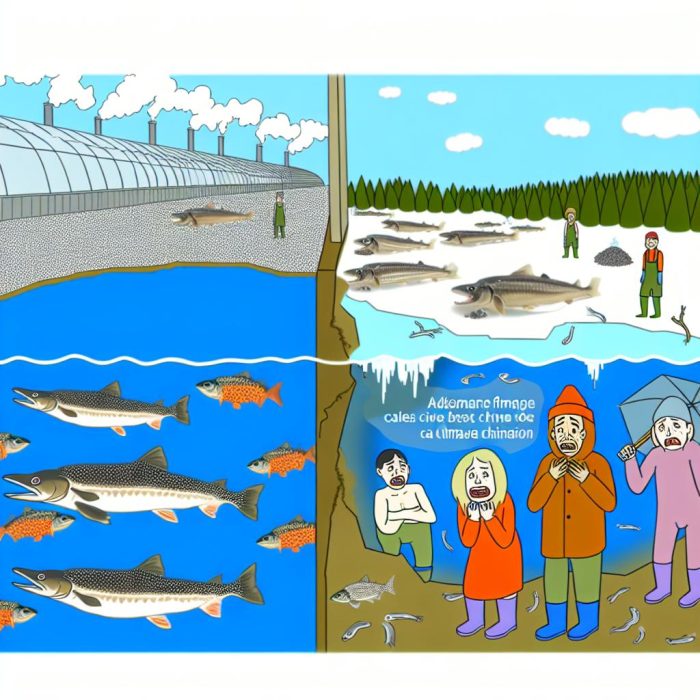Introduction
Caviar, a renowned delicacy derived from the roe of sturgeon fish, is synonymous with opulence and upscale dining. Its enigmatic allure has captivated the culinary world for centuries. Yet, beneath this allure lies an industry facing profound challenges posed by climate change. The complexities of caviar production are becoming increasingly intertwined with shifts in the climate, which pose significant risks to both the quality and quantity of this luxury food item. The following article delves into how climate change disrupts various facets of caviar production, presenting an in-depth look into the unique challenges faced by producers today.
Rising Water Temperatures
A consequence of global warming that has far-reaching impacts on aquatic ecosystems is the increase in water temperatures. As thermal profiles in water bodies change, the habitats of sturgeon fish, key sources of caviar, are adversely affected. The vulnerability of sturgeons to thermal fluctuations manifests through several critical ecological and biological dimensions.
The Biological Sensitivity of Sturgeon
Sturgeon, an ancient line of fish species, exhibit marked sensitivity to changes in their environment, especially temperature fluctuations. These fish have evolved over millions of years and are finely attuned to stable habitats. Rising water temperatures disrupt the delicate balance required for their growth, impacting physiological functions such as metabolism and immune system efficacy.
Oxygen Depletion
Higher water temperatures can directly lead to decreased oxygen solubility. This oxygen depletion stresses aquatic fauna, including sturgeon, compromising their survival. Low oxygen levels can result in stunted growth and mortality among juvenile fish, directly reducing population sizes and impacting caviar yield.
Impact on Sturgeon Reproduction
At the heart of caviar production lies the reproductive success of sturgeon. Reproduction in sturgeon is intricately linked to specific temperature regimes, and even mild deviations can have substantial consequences.
Disruption of Spawning Cycles
Altered temperature patterns can lead to premature or delayed spawning periods. Such disturbances in temporal spawning cycles can mismatch with optimal environmental conditions, such as food availability and appropriate nursery habitats, leading to reduced juvenile survival rates.
Deterioration of Fertility Rates
Temperature deviations might lead to reduced fertility among mature sturgeon, characterized by lower egg production and quality. As a result, the natural population growth is impeded, cascading into lower caviar output from natural sources. To delve deeper into this issue, the NOAA Fisheries offers comprehensive insights.
Changes in Freshwater Habitats
Freshwater systems are lifelines for many sturgeon species, serving as crucial spawning and nursery grounds. With climate change-induced modifications in these environments, sturgeon face unprecedented habitat challenges.
Altered Precipitation Patterns
Climate phenomena are altering precipitation cycles, impacting river flow regimes. These changes can lead to altered sediment deposition and river morphology, affecting the availability and quality of spawning substrates for sturgeon.
Floods and Droughts
An interconnected challenge stemming from climate shifts is the increased intensity and frequency of floods and droughts, both of which present significant threats to sturgeon habitats.
Impact of Flooding
Flooding events reshape riverbanks and spawning beds, which are essential for sturgeon egg deposition and development. These floods can displace eggs, reduce hatching success, and diminish the survival probability of young fish.
Consequences of Drought
Drought conditions, on the other hand, exacerbate habitat contraction, exposing sturgeon eggs to predators such as birds and other fish. Additionally, low water levels can lead to higher predation risks and increased vulnerability to temperature extremes, further threatening the survival rates of juvenile sturgeon.
Ocean Acidification
As atmospheric CO2 levels rise, the oceans simultaneously absorb this gas, leading to a process known as ocean acidification—a subtle yet impactful change in the aquatic environment.
Effects on Food Web Dynamics
For sturgeon residing partially in brackish waters, ocean acidification can severely disrupt the intricate food web upon which they rely. Alterations in pH levels can affect primary producers like phytoplankton and zooplankton, causing ripple effects throughout the food chain. Sturgeon may face challenges in finding adequate food resources, adversely affecting their growth and reproductive capabilities.
Conservation and Adaptation Measures
Acknowledging the challenges posed by climate change, concerted efforts are underway to mitigate its adverse effects on sturgeon populations and safeguard the caviar industry.
Habitat Restoration Initiatives
Efforts at the grassroots level are focusing on restoring and preserving vital sturgeon habitats. By stabilizing riverbanks, ensuring clean and stable water flow, and rebuilding spawning substrates, these initiatives aim to create conducive environments for sturgeon reproduction and growth.
Implementation of Captive Breeding Programs
In response to the declining wild sturgeon populations, captive breeding and aquaculture programs offer a ray of hope. By raising sturgeon in carefully controlled environments, producers can circumvent some environmental challenges and ensure a steady supply of high-quality caviar.
Sustainable Aquaculture Practices
Some caviar producers are turning to innovative aquaculture practices that simulate natural conditions while allowing for meticulous control over variables like temperature and water quality. These aquaculture systems often employ recirculating setups that require less water and reduce the risk of external pollution, making them an appealing option for sustainable production.
Collaborative Efforts for Sustainable Solutions
The global nature of climate change requires collaborative strategies. Stakeholders from environmental, governmental, and industry sectors are increasingly collaborating to develop policies aimed at reducing emissions and promoting conservation practices tailored to sturgeon ecology.
In comprehensively understanding and confronting these challenges, the caviar industry can work towards sustainable practices that secure the future of this cherished delicacy. Through continued research, innovation, and responsible management, it is possible to protect sturgeon populations and maintain the rich legacy of caviar production in the face of an ever-changing climate.

